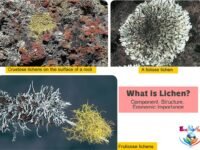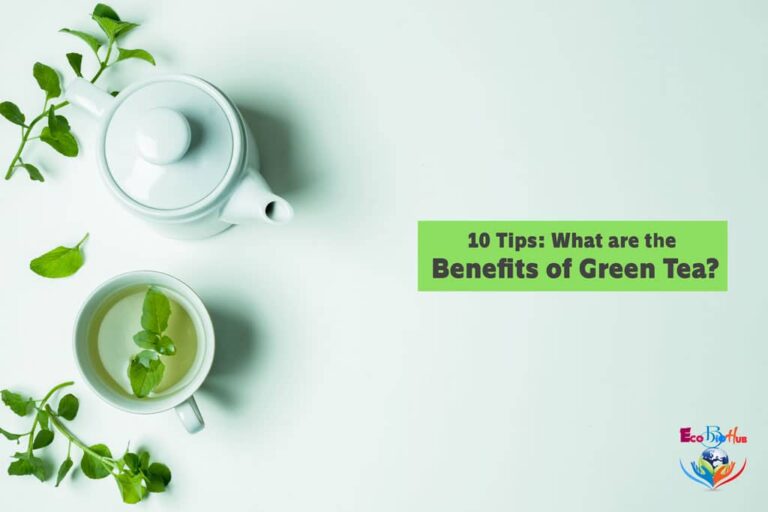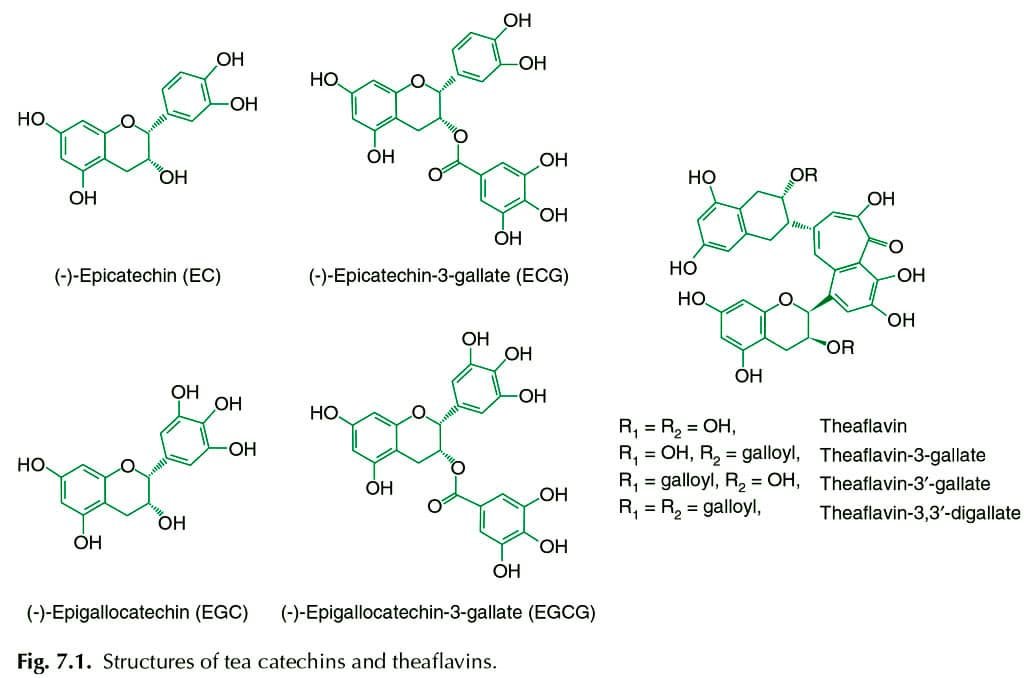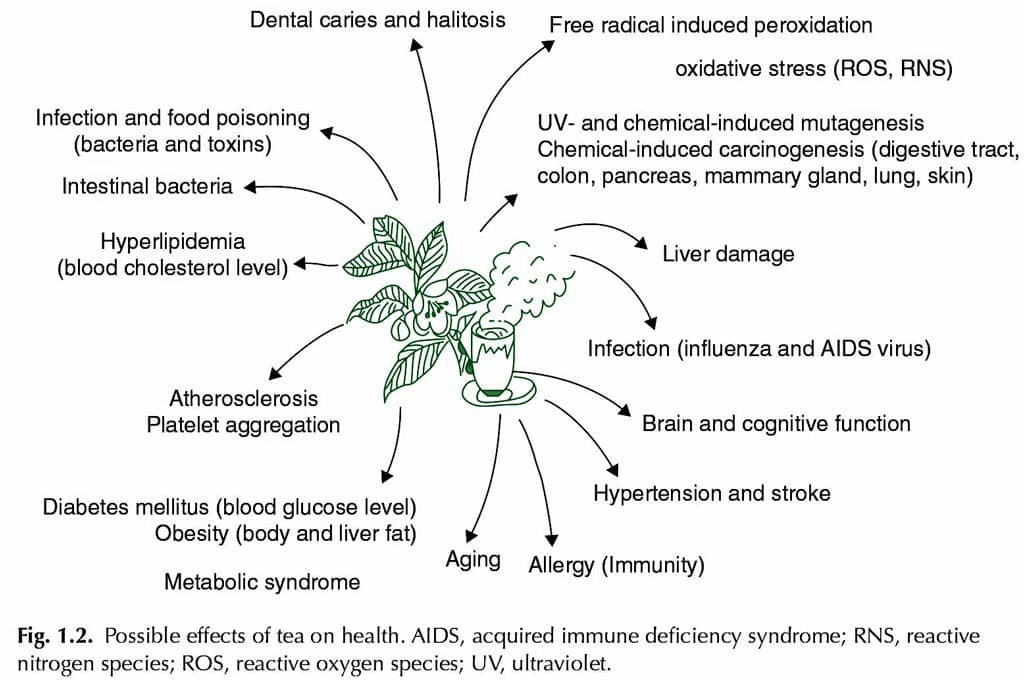In this tutorial, we have explained “What are the Benefits of Green Tea?“ along with its processing and its 10 major benefits.
TABLE OF CONTENTS
What is Green Tea?
The plant Camellia sinensis yields a variety of white, green, and black tea. In this tutorial, we are discussing the health benefits of green tea.
Green tea originated in China and its use for medicinal purposes was first documented in the 3rd Century B.C.
Much research is available depicting the health benefits of green tea for a wide variety of implications, including different types of cancer, heart disease, and liver disease. It is also a booster for our oral health. Green tea has an abundant concentration of antioxidants due to the presence of polyphenols.
Since the 1970s, epidemiological studies of cancer have shown that in parts of the world where green tea is consumed, the incidence of solid tumor cancers such as breast, lung, and gastrointestinal cancers is lower.
Several components in tea have specific health benefits (Suzuki et al., 2012, 2016; Yang et al., 2014). Among them, GTCs are associated with the anticancer, anti-obesity, anti-atherosclerotic, antidiabetic, antibacterial, antiviral, and anti-dental caries effects of tea (Yang et al., 2009, 2014; Suzuki et al., 2012, 2016). In most cases, epigallocatechin
gallate (EGCG) exhibits the highest activity.
The aromatized green teas are popular due to their aroma and organoleptic properties. The pharmaceutical effects of green tea include the prevention of cancer, antioxidative, antiviral, antibacterial, antifungal, lowering cholesterol, neuroprotective, anti-inflammatory & many more.
It is an evergreen shrub that grows primarily in tropical and subtropical climates and requires at least fifty inches of rainfall annually with a preference for well-drained soils having an acidic pH of 4.5 to 5.5.
The tea flowers are white and contain bright yellow stamens. Typically, flowering is prevented during cultivation by harvesting the leaves.
Tea can be broadly categorized into three main types, based on the level of fermentation that takes place during processing: green tea being unfermented; oolong tea being semifermented, and black tea fully fermented. Green, Black, and Oolong teas are all originated from the leaves of the Camellia sinensis plant.
Green tea is typically produced by harvesting the first two to three leaves and the bud, which have a unique flavour and aroma, from each plant.
➢ Scientific name: Camellia sinensis ➢ Type: Tea ➢ Originated Country: China ➢ Region of origin: East Asia ➢ Mostly cultivated countries: Green tea is mostly cultivated in China, India, Sri Lanka, Japan, Indonesia, and several African and South-American countries. Among these, China, India, Kenya, and Sri Lanka are the world leaders in tea production. ➢ Ingredients: Tea leaves The differences between individual types of tea result from variations in the processing of the tea leaves after they are harvested. Therefore, depending on the processing conditions, such as the extent of fermentation, the tea is classified into three basic categories: green tea (unfermented tea), oolong tea (midfermented tea), and black tea (fermented tea). Green teas are subject to minimal oxidation, whereas oolong and black teas are subjected to partial and extensive oxidation, respectively. The intent during the manufacturing of green tea is to preserve the healthy, natural, and active substances of the fresh tea leaves so they could be released into the consumer’s cup upon infusion. After picking (by hand or via mechanical means), the green leaves are spread out in the hot air to wither (moisture elimination). once they have become soft and pliable, they are traditionally panfried in traditional woks with a convex bottom specifically to inactivate enzymes (Wilson and Clifford, 1992). This process prevents the leaves from oxidizing (commonly known as fermenting), as occurs during the production of black tea. The subsequent “rolling” gives the leaves their shape and styles, such as twisted, curly, or balled, as well as increased durability. Rolling of the leaves also helps to regulate the release of natural substances and flavors during the steeping. The chemical composition of green tea varies with climate, season, horticultural practices, and position of the leaf on the The composition of green tea leaves is dependent on various factors such as geographical location, climate, season, horticultural practices, variety, and the age of tea leaves. Fresh tea leaves contain polyphenols, carbohydrates, lipids, proteins, amino acids, lignin, caffeine, chlorophyll, carotenoids, organic acids, minerals, and volatile flavor and aroma compounds The Green Tea Polyphenols (GTPs) are found in green tea leaves and are more commonly known as flavanoids or catechins. One of the main catechins is a rich antioxidant called Epigallocatechin-3-gallate (EGCG). EGCG is 100 times more effective than Vitamin C and 25 times more effective than Vitamin E at protecting cells and DNA from free radical damage linked to many diseases. The leaf bud and the first leaves are rich in EGCG. The usual concentration of total polyphenols in dried green tea leaves is about 8% to 12%. This antioxidant has twice the benefits of Resveratrol, a polyphenol found in red wine, that is also known to limit the negative effects of smoking and a fatty diet. Green tea also contains alkaloids including caffeine, theobromine, and theophylline. These alkaloids provide green tea’s stimulant effects. Green tea has been shown to have many positive health effects, which include anti-cancer, anti-inflammatory, antioxidant, antimicrobial, cardiovascular, dermatologic, hematologic, metabolic, and neurological effects. Oxidation is an essential part of many natural metabolic reactions in our body. It is the oxidation of some compounds, such as fats, that can lead to the creation of “free radicals” which are harmful to the body and can cause damage to our cells. Excessive build-up of these free radicals not only leads to cell damage but ultimately over time can result in various states of chronic diseases, inflammation, and accelerating the aging process. Some of these conditions include heart disease (resulting from LDL oxidation), renal disease and failure, several types of cancer, skin exposure damage caused by ultraviolet A and B rays, as well as many diseases associated with the onset of aging. Green tea is a rich source of antioxidants exhibited by the polyphenols (Catechins and Garllic acid are the major polyphenols) and polyphenols are potent free-radical scavengers due to the hydroxyl group in their chemical structure. These hydroxyl groups can bind with free radicals to neutralize them, preventing reactions between free radicals and DNA and resulting in mutations that can adversely affect the cell cycle and potentially lead to malignancy and other diseases. [Ref: Zhang, J., Shen, X. 1997]. The antioxidant property of green tea is greater than that of oolong tea or black tea. Green tea is effective against the human immunodeficiency virus (HIV), Epstein-Barr virus, herpes simplex virus, influenza virus & adenoviruses since the polyphenols present in green tea inhibit viral penetration into the cells, stops the action of viral enzymes (i.e., Neuraminidase) & cease viral RNA synthesis (Sinija V. R., Mishra H. N. Green tea: Health benefits. Journal of Nutritional & Environmental Medicine, 2008). Quantitative analysis revealed that at high concentrations of polyphenols like EGCG and ECG suppressed viral RNA synthesis in cells, whereas EGC failed to show a similar effect. Similarly, EGCG and ECG inhibited neuraminidase activity more effectively than EGC. Neuraminidase is an antigenic glycoprotein enzyme found on the surface of the influenza virus and it mainly aids in the efficiency of virus release from cells. Studies have shown that Epigallocatechin-3-gallate (EGCG) when used in conjunction with antimycotics decreases the growth of Candidia albicans, hence green tea was found to be an effective antifungal medication for Candidiasis (Ref: Wu CD, Wei GX. Tea as a functional food for oral health. Nutrition 2002; 18:443-4.) It has been reported that consumption of green tea polyphenols (GTPs) is related to decreased risk or slower progression of cancer of various organs (Khan and Mukhtar, 2010; Khan et al., 2008; Syed et al., 2007a). Analysis of studies performed that using human oral consumption of green tea gave the most consistent results and were positive for reduced cancer risk in breast, cardiac, colorectal, esophageal, gastric, lung, ovarian, pancreatic, and prostate cancers. (Ju, J.; Lu, G.; Lambert, J.D.; Yang, C.S. 2007. Boehm, K.; Borelli, F.; Ernst, E.; Habacher, G.; Hung, S.K.; Milazzo, S.; Hornebar, M. 2009). Scientific research also revealed that green tea may help prevent all three phases of tumour development: initiation, promotion, and progression. Epigallocatechin gallate (EGCG) and other tea catechins suppress tumour growth by inhibiting the release of tumour necrosis factor-alpha The polyphenols (EGCG is the major and most effective chemopreventive agent in green tea] prevents tumor initiation & promotion by inactivating its biochemical markers and inhibiting genotoxicity & mutagenicity. While the studies are not conclusive, green tea polyphenols, mainly EGCG, may be effective in preventing and/or inhibiting various cancers including prostate, breast, ovarian, liver, lung, skin, and leukemia. Green tea protects us from lung cancer by reducing cellular damage caused by cigarette smoke. A study conducted by the University of Arizona found that it reduces cellular damage by 25%. The skin is the largest organ of the body, comprising a surface area of approximately 1.5 to 2.0 m2, which protects the internal organs of the body against the detrimental effects of the external environment. Studies suggest that EGCG and green tea polyphenols have anti-inflammatory and anticancer properties that may help prevent the onset and growth of skin tumors. Topical application of EGCG may prevent UV-B–induced immunosuppression and precancerous cell changes after UV-B exposure (Ref: Santosh K, Hasan M. 2001). Obesity and overweight are linked to a cluster of metabolic and vascular disorders and represent a major and growing public health problem. Since excessive accumulation of visceral fat is closely related to metabolic syndrome that leads to abdominal visceral obesity. Due to obesity, some serious diseases have also been increased such as fatty liver, hyperlipidemia, sleep apnea syndrome, and high blood pressure. Moreover, obesity can lead to diabetes, arteriosclerosis, myocardial infarction, and stroke, causing death. The research suggested that green tea catechins help to prevent obesity by inhibiting lipid absorption and the induction of lipid metabolism in the liver, along with other mechanisms (Ref: Watanabe et al., 1998; Ikeda et al., 1992; Muramatsu et al. 1986;). After many studies and based on their reports, green tea catechins play an important role in fat reduction in the human body. The summarized reports are as follows: 01. The effective dose of green tea is 500 to 600 mg/day (Nagao et al., 2001, Takase et al., 2008a). 02. Green Tea catechins are effective in people inclined to be obese (with higher body mass index (BMI)) (Hase et al., 2001; Tsuchida et al., 2002; Otsuka et al., 2002; Kozuma et al., 2005; Maki et al., 2009; Nagao et al., 2005, 2007; Takase et al., 2008b). 03. Green Tea catechins have similar effects between sexes (Tsuchida et al., 2002; Kozuma et al., 2005). 04. Rebound phenomena are not observed after discontinuation of green tea (Tsuchida et al., 2002; Kozuma et al., 2005). 05. After investigation of more than 1000 subjects, their Physical and hematologic findings are normal. (Tsuchida et al., 2002; Kozuma et al., 2005). The EGCG in the green tea diet also acts with the compound caffeine (a small amount of this is found in green tea). The interaction of these two compounds causes a green tea diet to promote thermogenesis in the body that promotes faster metabolism of fats and sugars. It has been noted by a study published in the American Journal of Clinical Nutrition that, with the consumption of a green tea diet, the body’s total 24-hour energy expenditure is increased by up to 4%. This is roughly equivalent to losing more than 10 pounds of weight a month. The green tea diet helps increase the body’s metabolic rates. The result demonstrated in human trials that it may be possible to maintain proper body weight without dietary restriction through adequate daily physical exercise and green tea intake (Maki et al., 2009). Other potential routes through which tea catechins manifest their anti-obesity effects include: (i) decreasing appetite; (ii) decreasing nutrient absorption; and (iii) altering the composition of the gut microbiota. Due to the popularity of recent investigations and the positive result of using green tea in daily life, green tea has almost become synonymous with weight loss and diet. Diabetes mellitus (DM) is the most typical metabolic disease showing the irregular elevation of chronic and/or postprandial blood sugar levels. Under physiological situations, two peptide hormones, specifically insulin (β cells within the pancreas) and glucagon (α cells within the pancreas) are able to control blood glucose levels. At present, approx 400 million individuals worldwide undergo from this disease. After taking a meal, carbohydrates are degraded by digestive enzymes, generated glucose is absorbed in the small intestine, and enters the bloodstream resulting in the elevation of blood glucose levels. The blood glucose is transported and included in the liver, muscle, and adipose tissue, and then insulin secreted from pancreatic β cells regulate the blood glucose levels to normal. However, throughout fasting (hypoglycemic situation) glucagon secreted from pancreatic α cells facilitates the hepatic glycogen degradation to upregulate and preserve the blood glucose level normal. There are two types of Diabetes mellitus (DM): type I and type II DM. Type I DM is caused by the destruction of pancreatic β cells, which leads to impaired insulin secretion. Whereas type II DM is complicated but it involves genetic and environmental factors inflicting insulin resistance. Studies observed that green tea has been used to regulate blood sugar in the body. Different researches present that green tea results in decreases in body fats, particularly in the belly area. EGCG in green tea has been discovered to increase insulin sensitivity and may repair damaged beta cells (McKay DL, Blumberg JB, 2002). One examines from Japan reveals that those that drink quite a lot of green tea the potential to grow to be diabetes decreases by 42%. In accordance with an evaluation of seven research with a complete of 286,701 people, green tea drinkers had an 18% lower threat of becoming diabetic. Cardiovascular disease (CVD) is a complex disorder defined as a group of diseases that include dysfunctional conditions of the heart and blood vessel system and other disorders, like atherosclerosis, deep vein thrombosis, and pulmonary embolism, cerebrovascular accident (stroke), congestive heart failure, coronary artery disease (CAD), coronary heart disease (CHD), and myocardial infarction (MI) (heart attack). Cardiovascular disease (CVD) is the biggest cause of death in the world. The related causes of CVD include diabetes mellitus (DM), atherosclerosis, hypertension, hypercholesterolemia, and hyperhomocysteinemia (Venardos and Kaye, 2007). Oxidative stress is likely one of the main factors for the cause of such chronic diseases. Consuming green tea, numerous fruits and vegetables having antioxidant properties would possibly reduce the risk of cardiovascular disease (Misra et al., 2009). Epidemiological researches have clearly indicated that tea polyphenols from green tea are beneficial to protect against cardiovascular diseases (Riemersma et al., 2001; Wolfram, 2007; Hodgsonet et al., 2008). Green tea polyphenols and its catechins reduce the risk of CVD by reducing the plasma levels of cholesterol and triglycerides. Different plant polyphenols such as catechins, chlorogenic acid, pyrocatechol, quercetin, and rutin have been broadly acknowledged as health tonics (Graham et al., 1992; Sajilata et al., 2008). Green tea polyphenols (GTPs), rich in catechins, are well-known antioxidants that protect against several kinds of chronic diseases. After highly research on green tea, it was revealed that the multiple components such as theaflavins, caffeine, theophylline, phenolic acids, theobromine, and theanine found in green tea and those are valuable for health benefits (Cabrera et al., 2006). In general, green tea performs a crucial and beneficial role in various conditions likes cancer, diabetes, genital warts, obesity and weight management, metabolic health, and cardiovascular disease (Westerterp-Plantenga et al., 2005; Bettuzzi et al., 2006; Kuriyama et al., 2006; Gross et al., 2007; Nagao et al., 2007; Kurahashi et al., 2008). An unhealthy diet and physical inactivity are responsible for increasing blood glucose levels, blood pressure, and blood lipids, and lead to overweight, obesity, and Cardiovascular disease (CVD) (Nagao et al., 2007; Westerterp-Plantenga et al., 2005). Even secondary factors are also involved such as poverty, stress, and heredity. It has been observed that green tea drinkers have up to a 31% lower risk of cardiovascular disease. Daily 5 cups or more consumption of green tea may offer protection against cerebrovascular accident (stroke). Nitric oxide (NO) is a major mediator of endothelium-dependent vasodilation (EDV) and helps prevent thrombosis and arteriosclerosis. Nitric oxide (NO) is produced by the endothelium of arterioles in cerebral vessels. Green tea polyphenols/catechins may help to prevent strokes by increasing the expression of endothelial Nitric oxide synthase. A research of 40,530 Japanese adults, those that drank the green tea (5 or extra cups per day) had been considerably much less prone to die during an 11-year interval (60): • Death of all causes: 23% decrease in women, 12% decrease in men. • Death from heart disease: 31% decrease in women, 22% decrease in men. • Death from stroke: 42% decrease in women, 35% decrease in men. Extensive research has shown that green tea extracts not only have amazing antioxidant and cell-protective qualities but also protect collagen by inhibiting collagenase, which is a collagen-reducing enzyme responsible for the breakdown of collagen. Since green tea extracts are well known as a potent anti-inflammatory agent, they are capable of reducing inflammation in the skin through an inhibitory action on collagenase. As free radicals are liable to attack and damage the DNA of cells, the antioxidant property of green tea extracts performs a protective role to prevent free radical damage that would lead to skin tumors and cancers (Chiu and Kimball, 2003). The methylxanthines in green tea extracts assist to stimulate skin microcirculation, which further influences skin health. Green tea polyphenols can be utilized as an antiaging ingredient in skincare formulations in addition to assisting skin fight inflammation that might induce premature aging. Green tea polyphenols are additionally able to limit cell death when vigorously exposed to UV radiation and thus exhibit a cell-protecting function as well (Draelos, 2001; Ahmad and Mukhtar, 2001). EGCG, one of the important polyphenols in green tea extract, is generally identified to be 20 times more effective than vitamin E (tocopherols) for neutralizing free radicals since it is successfully absorbed through the skin and acts as an astringent to protect the skin. Additionally, green tea polyphenols exhibit a photoprotective effect when it applies to the skin and reduces erythema formation. At certain concentrations, the mixture of green tea polyphenols is useful in stimulating aged keratinocytes to generate organic energy, which helps to protect DNA and presumably renew cell division (Hsu et al., 2003). Remarks: Generally, it is recommended to use natural products for skin health since most commercial skin care products available on the market are formulated with synthetic chemical ingredients that can lead to harmful effects on the skin. Typically commercial skin care products are composed of harsh chemical compounds resembling surfactants, detergents, and preservatives that may rapidly dry up the skin due to the removal of natural protective oils from the skin, which leads to abrupt irritations and permanently drying out the skin, which may trigger allergic reactions. Currently, green tea extracts are broadly utilized in skin health restoration and cosmetic products including creams, lotions, cleansing solutions, toners, scrubs, and gels. These products boost microcirculation which leads to a healthy skin tone and function. Moreover, Green tea extracts provide desired astringent claims and assist to maintain the elasticity and firmness of the skin by protecting the cells in the skin from premature cell death from radiation or extravagant free radicals. Moreover, the advantage of green tea oil is widely accepted as a purely natural ingredient for skin health and the oil is derived from air-dried green teas only and is absolutely free from saponin including fatty acids. Due to its clear appearance makes it appropriate for cosmetic formulations. Green tea polyphenols (GTPs) present in green tea oil offer a number of amazing therapeutic benefits including natural healing property. Green tea oil comprises a number of useful substances, such as natural theanine and natural caffeine, that can relax and rejuvenate the human skin. As well as, caffeine can cause the skin to look fresher, more energizing, livelier, and younger by tightening up any slackness and removing small wrinkles, thus giving the skin an extra tranquil and brisker enchantment. Several studies revealed that active oxygen species developed when exposed to UV rays can severely damage skin by way of attacking DNA in skin cells, oxidizing collagen, and stimulating tyrosinase activities (Vayalil et al., 2004). Recently further studies confirmed that the application of green tea extracts protects against skin damage associated with ultraviolet radiation from the sun. Green tea polyphenols (GTPs) are known to absorb UVA and UVB rays and have emerged as a significant substance in skin care (sunscreen) applications (McCook et al., 1994). Additionally, green tea polyphenols are evaluated for promoting skin regeneration and are also used for healing or treatment of certain epithelial conditions, such as aphthous ulcers, psoriasis, rosacea, and actinic keratosis. The leaves of tea contain antioxidative polyphenols. Among them, epigallocatechin-3-gallate (EGCG) is a principal component or catechin. Several epidemiologic investigations have shown that flavonoid intake (Hertog et al., 1997; Huxley and Neil, 2003) and green tea catechins (GTC) (Velayutham et al., 2008; Wang et al., 2011) exert beneficial effects on cardiovascular diseases. One cup of green tea/day decreased coronary artery disease by 10% (Wang et al. 2011). Epidemiologic studies on cerebrovascular disease showed that daily tea drinking (Sato et al., 1989; Keli et al., 1996; Arab et al., 2009) and flavonoid intake (Hollman et al., 2010) reduced the risk of stroke. Kuriyama et al. (2006) carried out a follow-up study over 11 years and reported that green tea consumption was inversely associated with mortality due to cardiovascular diseases, stroke, and cancer.
Processing of Green Tea
Finally, the tea leaves are dried by firing, whereby the natural fragrances and flavors are stabilized, helping the tea leaves maintain their original texture and green color.Constituents of Green Tea
harvested shoot. The major components are polyphenols, particularly catechins. Green tea catechins belong to the biochemical family of dietary flavonoids. The four major flavonoids in green tea are the catechins epicatechin (EC)
Constituents
Examples
Polyphenols
Four groups of Catechins:
Epigallocatechin-3-gallate(EGCG),
Epigallocatechin(EGC),
Epicatechin three gallate(EGC),
Epicatechin(EC)
Proteins
Enzymes
Amino Acids
Teanine, 5-Nethylglutamine, Tryptophan, Glutamic acid, Glycine, Serine, Aspartic acid, Valine, Leucine, Theonine, Tryosine, Lysine
Sterols
Stigmasterol
Vitamins
A, B1, B2, B6, E, Niacin, Folic Acid, Ascorbic Acid
Xanthic Compounds
Caffeine, theobromine, theophylline
Carbohydrates
Cellulose, Glucose, Pectin, Fructose, Sucrose
Lipids
Linolenic & Linoleic acids
Pigments
Chlorophyll & Carotenoids
Volatile Compounds
Aldehydes, alcohols, ketones, esters and lactones, acids, hydrocarbons
Minerals & Trace Elements
Ca, Mg, Fe, Cu, Cr, Zn, Na, P, K, Se, Sr, Co, F, Ni
Phenolic Acids
Caffeic acid, Gallic acid, Chlorogenic acid
Flavones
Apigenin, Luteolin
Flavonols
Kaempferol, Myricetin, Quercetin, Rutine
What are Green Tea Polyphenols (GTPs)?
Benefits of Green Tea: Is Green Tea Good for You
(i) Benefits of Green Tea: ANTIOXIDANT Property
(ii) Benefits of Green Tea: ANTIVIRAL Property
(iii) Benefits of Green Tea: ANTIFUNGAL Property
(iv) Benefits of Green Tea: Prevent CANCER
(v) Benefits of Green Tea: Prevent SKIN CANCER
(vi) Green tea for Weight Loss
(vii) Benefits of Green Tea: Prevent DIABETES
(viii) Benefits of Green Tea: Prevent CARDIOVASCULAR DISEASE (CVD)
(ix) Green tea benefits for Skin
(x) Benefits of Green Tea: Protect HEART























